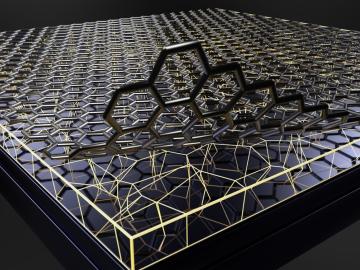
Filter News
Area of Research
- Biology and Environment (4)
- Clean Energy (14)
- Climate and Environmental Systems (2)
- Computer Science (1)
- Energy Sciences (1)
- Fusion Energy (4)
- Materials (8)
- Materials for Computing (1)
- National Security (4)
- Neutron Science (4)
- Nuclear Science and Technology (4)
- Nuclear Systems Modeling, Simulation and Validation (2)
- Supercomputing (6)
News Type
Date
News Topics
- 3-D Printing/Advanced Manufacturing (3)
- Advanced Reactors (6)
- Artificial Intelligence (3)
- Big Data (7)
- Bioenergy (1)
- Biology (3)
- Biomedical (6)
- Buildings (3)
- Chemical Sciences (4)
- Clean Water (2)
- Climate Change (11)
- Composites (1)
- Computer Science (8)
- Coronavirus (3)
- Critical Materials (1)
- Decarbonization (3)
- Energy Storage (10)
- Environment (12)
- Fossil Energy (1)
- Frontier (1)
- Fusion (3)
- Grid (4)
- High-Performance Computing (2)
- Isotopes (1)
- ITER (1)
- Machine Learning (6)
- Materials (2)
- Materials Science (11)
- Mathematics (1)
- Microscopy (2)
- Molten Salt (1)
- Nanotechnology (2)
- Net Zero (1)
- Neutron Science (5)
- Nuclear Energy (7)
- Polymers (3)
- Simulation (3)
- Summit (3)
- Sustainable Energy (11)
- Transportation (6)
Media Contacts

Scientists at the Department of Energy’s Oak Ridge National Laboratory are using a new modeling framework in conjunction with data collected from marshes in the Mississippi Delta to improve predictions of climate-warming methane and nitrous oxide.

Researchers demonstrated that stainless steel and other metal alloys coated with hexagonal boron nitride, or hBN, exhibit non-stick or low-friction qualities along with improved long-term protection against harsh corrosion and high-temperature.

Electric vehicles can drive longer distances if their lithium-ion batteries deliver more energy in a lighter package. A prime weight-loss candidate is the current collector, a component that often adds 10% to the weight of a battery cell without contributing energy.

If air taxis become a viable mode of transportation, Oak Ridge National Laboratory researchers have estimated they could reduce fuel consumption significantly while alleviating traffic congestion.
Oak Ridge National Laboratory and collaborators have discovered that signaling molecules known to trigger symbiosis between plants and soil bacteria are also used by almost all fungi as chemical signals to communicate with each other.

Researchers at Oak Ridge National Laboratory are developing a first-of-a-kind toolkit drawing on video game development software to visualize radiation data.


Researchers at Oak Ridge National Laboratory were part of an international team that collected a treasure trove of data measuring precipitation, air particles, cloud patterns and the exchange of energy between the atmosphere and the sea ice.

Scientists from Oak Ridge National Laboratory used high-performance computing to create protein models that helped reveal how the outer membrane is tethered to the cell membrane in certain bacteria.

Oak Ridge National Laboratory researchers proved that the heat transport ability of lithium-ion battery cathodes is much lower than previously determined, a finding that could help explain barriers to increasing energy storage capacity and boosting performance.


